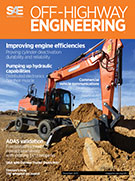Journal Article
Ensuring Fuel Economy Performance of Commercial Vehicle Fleets Using Blockchain Technology
2019-04-02
2019-01-1078
In the past, research on blockchain technology has addressed security and privacy concerns within intelligent transportation systems for critical V2I and V2V communications that form the backbone of Internet of Vehicles. Within trucking industry, a recent trend has been observed towards the use of blockchain technology for operations. Industry stakeholders are particularly looking forward to refining status quo contract management and vehicle maintenance processes through blockchains. However, the use of blockchain technology for enhancing vehicle performance in fleets, especially while considering the fact that modern-day intelligent vehicles are prone to cyber security threats, is an area that has attracted less attention. In this paper, we demonstrate a case study that makes use of blockchains to securely optimize the fuel economy of fleets that do package pickup and delivery (P&D) in urban areas.




